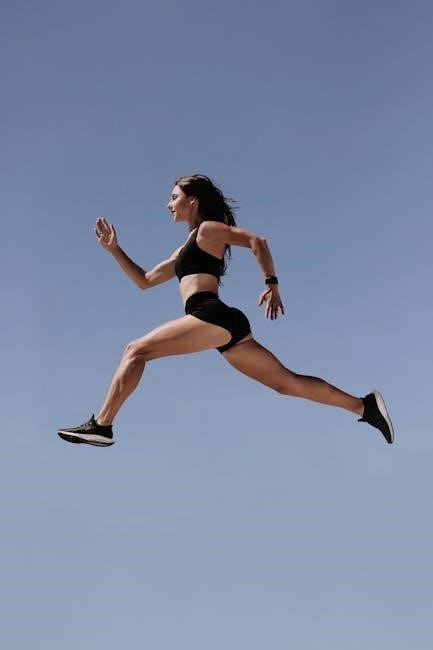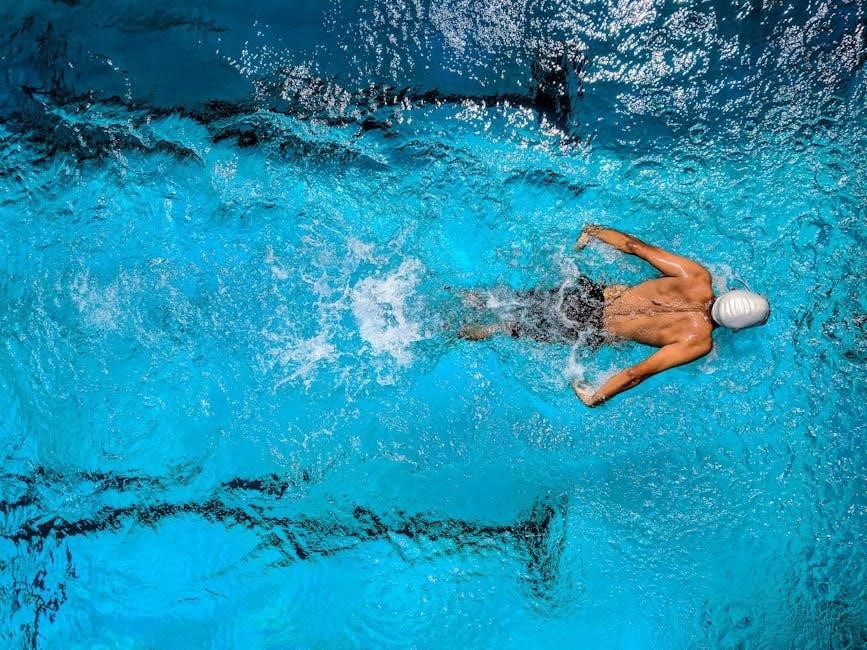Exercise physiology explores the body’s responses to physical activity, examining how physiological systems adapt to exercise. The 8th edition of Physiology of Sport and Exercise provides a comprehensive guide, detailing the interplay of cardiovascular, respiratory, and muscular systems during exercise, supported by visual aids and research-based insights.
1.1 Definition and Scope
Exercise physiology is the scientific study of the body’s physiological responses to physical activity. It examines how the cardiovascular, respiratory, and muscular systems adapt to exercise. The scope of exercise physiology extends to understanding energy production, thermoregulation, and neurological control during movement. It also explores environmental influences, such as altitude and temperature, on physical performance. This field is essential for optimizing athletic performance, improving health, and preventing injuries. The Physiology of Sport and Exercise, 8th Edition, provides a comprehensive overview, detailing the interplay of physiological systems and their responses to various exercise intensities and conditions, making it a vital resource for both students and professionals.
1.2 Historical Perspective
The study of exercise physiology has evolved significantly over the past century. Early investigations focused on understanding energy production and muscle function during physical activity. Pioneers in the field, such as A.V. Hill and Otto Meyerhof, laid the foundation by exploring cellular respiration and metabolic pathways; The 20th century saw advancements in understanding cardiovascular and respiratory responses to exercise. Modern research, as detailed in the Physiology of Sport and Exercise, 8th Edition, integrates cutting-edge technology and interdisciplinary approaches to explore the complexities of human physiology during sport and exercise. This historical progression has transformed exercise physiology into a vital science for optimizing performance and health.

Muscle Physiology
Muscle physiology examines the structure, function, and adaptation of skeletal muscles. The Physiology of Sport and Exercise, 8th Edition details muscle fiber types, contraction mechanisms, and training responses.
2.1 Skeletal Muscle Structure
Skeletal muscle structure is organized hierarchically, from gross anatomy to microscopic detail. It begins with the epimysium, a fibrous sheath enclosing the entire muscle, and the perimysium, which surrounds muscle fascicles. Each fascicle contains numerous muscle fibers, long, multinucleated cells responsible for contraction. The sarcolemma, the fiber’s plasma membrane, encloses myofibrils, which consist of repeating units called sarcomeres. Myofibrils are composed of actin (thin) and myosin (thick) filaments, arranged to facilitate sliding during contraction. The sarcoplasm, the fiber’s cytoplasm, houses mitochondria and the sarcoplasmic reticulum, essential for energy production and calcium regulation. This intricate structure enables skeletal muscles to generate force for movement and maintain posture.
2.2 Muscle Fiber Types
Muscle fibers are categorized into distinct types based on their contraction speed, fatigue resistance, and metabolic properties. The primary types are Type I (slow-twitch) and Type II (fast-twitch) fibers. Type I fibers are rich in myoglobin, rely on oxidative phosphorylation, and are efficient for endurance activities due to their high capillary density and resistance to fatigue. Type II fibers, subdivided into IIa and IIx, are anaerobic, relying on glycolysis for energy. Type IIa fibers have some oxidative capacity, making them versatile, while Type IIx fibers are specialized for high-intensity, short-duration efforts. The proportion of these fibers varies among individuals, influencing athletic performance and trainability. This diversity allows muscles to adapt to various demands, optimizing function across different exercise modalities.
2.3 Mechanisms of Muscle Contraction
Muscle contraction is governed by the sliding filament theory, where actin and myosin fibers interact to produce movement. This process begins with the activation of motor units, as nerve impulses trigger the release of calcium ions. These ions bind to troponin and tropomyosin, exposing myosin-binding sites on actin fibers. Myosin heads then form cross-bridges with actin, undergoing a conformational change that pulls actin past myosin, shortening the sarcomere. ATP hydrolysis provides the energy for this process, with ATP binding to myosin heads to reset their position. This cyclical interaction allows for sustained contraction until neural stimulation ceases, enabling precise control over muscle movement and force generation.

Energy Systems
Energy systems are essential for providing energy during exercise, involving ATP-PC, glycolytic, and oxidative pathways. Each system contributes uniquely based on exercise intensity and duration.
3.1 ATP-PC System
The ATP-PC system is the primary energy source for short-duration, high-intensity activities. It relies on stored ATP and phosphocreatine, providing immediate energy without oxygen. This system is exhausted within 10 seconds of maximal effort, making it crucial for sprinting and power exercises. The 8th edition of Physiology of Sport and Exercise emphasizes its role in rapid energy supply, highlighting its importance in sports performance and training. This system’s efficiency is vital for athletes requiring quick bursts of energy, as it directly impacts muscular power and speed.
3.2 Glycolytic System
The glycolytic system provides energy for moderate to high-intensity activities lasting up to 2 minutes. It breaks down glucose to pyruvate, producing a limited amount of ATP without oxygen. This anaerobic process is vital for sports requiring quick bursts of energy, such as sprinting or interval training. The 8th edition of Physiology of Sport and Exercise details how lactate accumulates as a byproduct, leading to muscle fatigue. Understanding this system is crucial for optimizing training programs, as it highlights the importance of balancing intensity and recovery to enhance athletic performance and delay the onset of fatigue.
3.3 Oxidative System
The oxidative system, also known as the aerobic system, is the body’s most efficient energy producer, relying on oxygen to break down carbohydrates and fats into ATP. This system is crucial for prolonged, low-to-moderate intensity activities like distance running or cycling. The 8th edition of Physiology of Sport and Exercise explains how the oxidative system maximizes energy production while minimizing fatigue. It emphasizes the role of mitochondrial function and oxygen delivery in sustaining performance. Understanding this system is essential for designing endurance training programs, as it highlights the importance of improving cardiovascular and muscular efficiency to enhance long-duration athletic performance.

Cardiovascular Responses to Exercise
Exercise triggers significant cardiovascular adaptations, including increased heart rate and stroke volume, ensuring enhanced blood flow and oxygen delivery to active muscles, as detailed in the 8th edition.
4.1 Heart Rate and Stroke Volume
During exercise, heart rate and stroke volume increase to meet the body’s heightened demand for oxygen and nutrients. The 8th edition explains that heart rate rises due to sympathetic nervous system activation, while stroke volume enhances through increased preload and contractility. These adaptations ensure adequate blood flow to active muscles. The textbook details how these mechanisms vary with fitness levels and environmental conditions, providing a comprehensive understanding of cardiovascular responses during physical activity.
4.2 Blood Pressure Regulation
Blood pressure regulation during exercise involves a balance between vasoconstriction and vasodilation. The 8th edition highlights that sympathetic nervous system activity increases, causing vasoconstriction in non-exercising tissues, while vasodilation occurs in active muscles due to local metabolites. This dual mechanism ensures optimal blood flow distribution. The textbook also explains the role of the baroreflex in maintaining arterial pressure, adjusting heart rate and stroke volume to prevent excessive fluctuations. These adaptations are crucial for sustaining performance and overall cardiovascular health during physical activity, as detailed in the comprehensive analysis provided by the 8th edition of Physiology of Sport and Exercise.
4.3 Peripheral Blood Flow
Peripheral blood flow adjusts dynamically during exercise to meet metabolic demands. The 8th edition explains that blood flow increases significantly in active muscles due to vasodilation, mediated by local metabolites like nitric oxide and prostaglandins. Conversely, blood flow decreases in non-essential organs via vasoconstriction. This redistribution ensures efficient oxygen and nutrient delivery to exercising tissues while maintaining central blood pressure. The textbook also highlights the role of the muscle metaboreflex, which regulates blood flow based on muscle activity intensity. Such adaptations optimize performance and prevent ischemia in critical areas, as thoroughly detailed in the 8th edition of Physiology of Sport and Exercise.

Respiratory System
The respiratory system adapts to exercise by increasing ventilation to meet heightened oxygen demands, ensuring efficient gas exchange and maintaining acid-base balance during physical activity.
5.1 Ventilation and Gas Exchange
Ventilation increases during exercise to enhance oxygen intake and carbon dioxide removal. The 8th edition highlights how deeper breathing and higher respiratory rates improve gas exchange efficiency, ensuring optimal oxygen delivery to muscles and organs, with detailed visual aids illustrating these processes.
5.2 Oxygen Delivery and Utilization
Oxygen delivery and utilization are critical for energy production during exercise. The 8th edition explains how hemoglobin and myoglobin facilitate oxygen transport to tissues. During intense activity, increased blood flow and capillary density enhance oxygen delivery to muscles, improving endurance. The textbook highlights how oxidative phosphorylation efficiently utilizes oxygen for ATP production, supporting sustained performance. Visual aids and research-based examples illustrate how oxygen utilization adapts to varying exercise intensities and environmental conditions, such as high altitude, optimizing physiological responses for peak performance.

Thermoregulation During Exercise
Exercise generates heat, requiring the body to regulate temperature through sweating and blood flow adjustments. The 8th edition details how the body maintains core temperature during activity.
6.1 Heat Production and Loss
During exercise, the body produces heat primarily through muscle contractions, with only about 25-30% of energy converted into work, the rest generating heat. This heat must be dissipated to maintain homeostasis. Sweat evaporation is the primary mechanism for heat loss, facilitated by increased blood flow to the skin. Environmental factors, such as humidity and temperature, significantly influence the efficiency of heat loss. The 8th edition of Physiology of Sport and Exercise elaborates on how the body balances heat production and loss, ensuring optimal performance and preventing heat-related illnesses.
6.2 Sweating Mechanisms
Sweating is a critical thermoregulatory mechanism during exercise, controlled by the autonomic nervous system. The hypothalamus, acting as the body’s thermostat, activates sweat glands in response to rising core temperature. Eccrine glands, primarily responsible for thermoregulatory sweating, secrete a hypotonic fluid onto the skin’s surface. As sweat evaporates, it cools the body, maintaining thermal balance. The rate of sweating depends on factors like fitness level, acclimatization, and environmental conditions. The 8th edition of Physiology of Sport and Exercise details how sweating efficiency varies among individuals and how environmental humidity impacts evaporation, emphasizing its role in preventing heat-related illnesses during intense or prolonged exercise.

Neurological Control of Movement
Neurological control involves the central nervous system coordinating muscle movements through motor units and neural pathways, ensuring precise and efficient physical performance during exercise and sport activities.
7.1 Motor Unit Activation
Motor unit activation is the process by which motor neurons and their associated muscle fibers are recruited to produce movement. During exercise, the central nervous system activates motor units in a specific order, starting with smaller, low-threshold units for precise movements and progressing to larger, high-threshold units for high-force tasks. This recruitment pattern ensures efficient energy use and optimal performance. The 8th edition of Physiology of Sport and Exercise details how motor unit activation varies with exercise intensity and fiber type, emphasizing the role of ATP-PC and oxidative systems in sustaining activity. This activation is crucial for understanding human movement and exercise responses.
7.2 Reflexes and Coordination
Reflexes and coordination are essential for precise and efficient movement during exercise. Reflexes are rapid, involuntary responses to stimuli, such as stretch reflexes that protect muscles from overextension. Coordination involves the integration of sensory input, neural processing, and muscle activation to produce smooth, purposeful movements. The nervous system plays a central role in modulating these processes, ensuring synchronization between different muscle groups. The 8th edition of Physiology of Sport and Exercise highlights how reflexes and coordination adapt to varying exercise demands, enabling athletes to perform complex tasks with accuracy and control. This adaptation is vital for optimizing performance and minimizing injury risk during physical activity.

Environmental Influences
Environmental factors like altitude, temperature, and humidity significantly impact physiological responses to exercise, affecting performance and health, as detailed in the 8th edition of Physiology of Sport and Exercise.
8.1 High Altitude
High-altitude environments pose unique physiological challenges due to lower oxygen levels. At elevated altitudes, the body adapts through increased erythropoietin production, stimulating red blood cell production to enhance oxygen delivery. However, acute exposure can lead to Acute Mountain Sickness (AMS), characterized by headaches, fatigue, and nausea. Prolonged exposure allows the body to acclimatize, improving oxygen utilization efficiency. The Physiology of Sport and Exercise, 8th Edition, details how high-altitude training affects athletic performance, including reduced maximal oxygen uptake (VO2 max) and altered metabolic responses. Understanding these adaptations is crucial for optimizing performance and mitigating health risks in high-altitude conditions, as extensively discussed in the textbook.
8.2 Heat and Humidity
Exercising in hot and humid environments significantly impacts physiological responses, primarily due to impaired heat dissipation. High humidity reduces sweat evaporation efficiency, leading to increased core temperature and cardiovascular strain. The body adapts by increasing sweat production and redirecting blood flow to the skin, but prolonged exposure can result in dehydration and heat-related illnesses. Acclimatization enhances the body’s ability to cope with heat stress by improving sweating mechanisms and cardiovascular efficiency. The Physiology of Sport and Exercise, 8th Edition, provides detailed insights into heat acclimatization strategies and the physiological responses to exercise in hot environments, emphasizing practical applications for athletes and trainers to optimize performance and safety in such conditions.
8.3 Cold Environments
Exercising in cold environments presents unique physiological challenges, primarily because the body must maintain its core temperature despite increased heat loss. The body responds by reducing blood flow to the skin through vasoconstriction, minimizing heat loss, and increasing heat production through shivering and elevated metabolic rate. Acclimatization to cold environments involves physiological adaptations, such as increased sympathetic nervous system activity and enhanced cold-induced vasodilation, improving blood flow to extremities during prolonged exposure. Behavioral adaptations, like wearing appropriate clothing and adjusting exercise intensity, are crucial for maintaining thermal balance and preventing hypothermia. Additionally, the book discusses specific acclimatization strategies and practical applications to enhance performance and safety in cold conditions.

Exercise Training Principles
This section introduces fundamental principles guiding effective exercise training, including progressive overload, specificity, and periodization, essential for enhancing performance and ensuring safe, adaptive physiological responses.
9.1 Overload and Progression
Overload and progression are fundamental principles in exercise training, ensuring continued adaptation and improvement. Overload involves challenging muscles beyond their current capacity, stimulating strength and endurance gains. Progression systematically increases exercise intensity, volume, or resistance to avoid plateaus. The 8th edition of Physiology of Sport and Exercise emphasizes applying these principles safely, tailoring them to individual fitness levels and goals. Proper progression prevents overtraining and injury, while optimizing physiological responses. These concepts are vital for designing effective training programs, whether for athletes or general fitness enthusiasts, ensuring long-term success and adaptation. The text provides practical strategies for implementing overload and progression effectively.
9.2 Specificity and Periodization
Specificity and periodization are cornerstone principles in exercise training, ensuring that programs align with specific goals and promote optimal adaptation. Specificity tailors training to the demands of a sport or activity, enhancing relevant physiological and performance outcomes. Periodization structures training into phases, balancing intensity, volume, and recovery to prevent overtraining and maximize performance. The 8th edition of Physiology of Sport and Exercise highlights how these principles enhance athletic preparation, offering practical examples for implementation. By integrating specificity and periodization, coaches and athletes can design targeted, effective training plans that address individual needs and achieve peak performance. These strategies are essential for long-term success in sports and fitness.

Special Populations
Special populations include individuals with unique physiological needs, such as the elderly, youth, and those with chronic conditions. The 8th edition addresses these groups’ specific exercise responses and adaptations, providing tailored strategies for safe and effective training. It emphasizes how age, health status, and fitness levels influence exercise outcomes, ensuring personalized approaches to enhance performance and well-being.
10.1 Aging and Exercise
Aging significantly impacts physiological systems, reducing muscle mass, cardiovascular efficiency, and metabolic rate. The 8th edition of Physiology of Sport and Exercise highlights how exercise counters age-related declines, improving mobility and health. It discusses age-specific responses to training, emphasizing the importance of tailored programs. The textbook provides evidence-based strategies to enhance strength, endurance, and flexibility in older adults, addressing chronic conditions and promoting functional independence. By understanding age-related physiological changes, exercise professionals can design safe and effective programs, optimizing health outcomes for aging populations.
10.2 Exercise for Different Fitness Levels
Exercise programs must be tailored to individual fitness levels, from sedentary to highly trained athletes. The 8th edition of Physiology of Sport and Exercise emphasizes the importance of progression and overload to enhance performance. It outlines how physiological responses, such as cardiovascular improvements and muscular adaptations, vary across fitness levels. The textbook provides practical strategies for designing programs that account for individual differences, ensuring safety and effectiveness. By understanding how fitness levels influence exercise responses, professionals can create personalized plans that promote long-term health and performance, regardless of the starting point. This approach fosters inclusivity and maximizes benefits for diverse populations.
